Core Trainer, Week 2
by Jitesh Gandhi on February 6, 2010 3:22 PM, under Life, Physical Therapy
I needed a couple more days of rest, but I did get back to using the Core Trainer. The DVDs provided some insight on how to get the most out of the Core Trainer and there was also a small segment on its use at the Center for Spinal Cord Injury Recovery in Detroit. They showed a couple people using it briefly. I’m not sure if both of those people were tall or the unit was shorter because both of them seemed to have their feet on the ground without them coming up. My feet sometimes come off the ground while it is moving.
The mirror is very helpful. I can see when I’m not level and correct it. I can also kind of target an area to try and keep my torso within so I know that I am keeping myself as straight as I can. I also stop using the Core Trainer when I can no longer stay pretty straight. The time I ride it has steadily increased over the week. I also think how long I can stay up straight (no slouching, sacral sitting) is improving. I won’t know for sure without using a stop watch or until I can do it for 3 minutes straight. The display on the Core Trainer counts down from 15 minutes with 5 LEDs, so you only know when you have less than 15, 12, 9, 6 and 3 minutes left.
Getting on and off has become easier the more I do it. I’m able to do it with only one person to help now that I feel more comfortable with it (there is really just a sense that there is nothing to really hold on to, so my biggest worry is sliding off the seat.).
I think the next thing I want to try is to do it without holding the handle to get a sense of the difference in difficulty. Up to now, I have always used the handle, and I think there is no way I could get rocked too much to cause me to go too far in any direction. I’m curious how much holding the handle helps me.
Some pictures of me on the Core Trainer trying to sit straight (it’s hard without seeing myself in a mirror!)
Tablet Follow-Up
by Jitesh Gandhi on February 6, 2010 2:13 PM, under Computer Hardware, Technology
Following up on my last post on the iPad, I came across some tablet related items that I liked.
The first was an announcement of an iPad look-alike that runs Windows 7 from a company called ExoPC. The slate is quick to point out that it will have “full support of all formats including Flash and Silverlight”. I’m not sure how the performance of it will be, but if it is smooth, I think it will deliver a good experience. The screen resolution is lower, which does hurt it. Fortunately, it is only reduced in one direction, so it should not hurt the web experience. The integrated web cam makes a lot of sense but it doesn’t mention a microphone. If it includes that, then you can run Skype on it. Weaker battery life and no 3G, but it has USB. Since it is running Windows 7, you will have full control of the tablet and won’t be locked in to Apple everything.
The second was a semi-critique of the iPad. I thought it was a good way to explain why the product seems like such a disappointment. I also like the simplicity in the statement “”With this, you can finally…” to determine how innovative a product is.
The final item was concept UI that Google put up a couple days before the iPad announcement. After the ipad announcement, my brother and I felt that Google was best positioned to directly challenge the iPad because they have their own mobile OS (Android) and are working on their own Chrome OS. A couple days later, it was reported Steve Jobs said “We did not enter the search business. They entered the phone business. Make no mistake they want to kill the iPhone.” in reference to Google during a company town hall meeting. He then tossed in “I want to go back to that other question first and say one more thing, he says. This don’t be evil mantra: ‘It’s bullshit.'” for good measure. I don’t think he’d waste his time talking about Google if he didn’t see them as a real threat.
All this talk of tablets also has me thinking. Multi-touch is not the best friend of people with physical disabilities. The gestures should really have an ability to be customized to allow those with limitations to decide what gestures are most important or maybe even different ways to perform the gesture to enable the same action.
Super Bowl Commercials
by Jitesh Gandhi on February 6, 2010 1:38 PM, under Entertainment, Politics, TV
CBS has created a small mess in choosing what commercials will be allowed to air during the Super Bowl. It started with the Tim Tebow and his mother’s commercial advocating for life. It is reported to be Pam Tebow’s story about choosing to continue her pregnancy despite the urging of doctor’s that she have an abortion because of the risks of the pregnancy. This of course turned into a Pro-Life/Pro-Choice war.
The underlying message in favor of life is a good one. I don’t quite get this commercial. Is it supposed to mean more because Tim Tebow is famous? Could there be a commercial where the mother of someone like Slobodan Miloševic? (if she is still alive) says she was urged to have an abortion but didn’t. Is that what Pam Tebow is implying? I think the spot would be more appropriate with commercial actors instead. The biggest issue people seem to have is that it is being paid for by Focus on the Family who have a public Pro-Life stance. If they had their way, people like Pam Tebow would not have a choice to make. (On a slight aside, people are actually questioning the validity of this story because Pam Tebow was told this in the Philippines where abortion was and still is illegal in all circumstances.)
CBS then went ahead and muddied the waters by rejecting a commercial from a male gay dating site, Man Crunch. It certainly seems like they are applying different standards to what is acceptable to air in these situations. There seemed to be plenty of push back against the Focus on the Family commercial. On the positive side, Man Crunch got a lot of free advertising without having to hand over $2.5-2.8M. Something to keep in mind for start up companies next year.
Using the Flex Bay in a Dell Precision T5500
by Jitesh Gandhi on February 6, 2010 11:06 AM, under Computer Hardware, Technology
I wanted to add a hard drive to my PC for additional storage of media. I plan to mirror my primary drive and I don’t want to clutter it up with media. I want to use it only for applications and work. The Dell Precision T5500 in a mini-tower configuration has what Dell calls a flex bay. You can have an internal drive or an external drive in that bay.
I’ve had good luck with Dell service manuals in the past, but the one for the T5500 is of no real help when it comes to the drive bays, especially the flex bay. It took a little bit of figuring out, but I managed to get the hard drive installed, so I thought it might help others to explain how I did it.
Dell has good instructions in their service manual for the T5500 for some of the steps. I will also make use of some of their pictures as well. So here we go.
- Follow the service manual for removing the Cover (pulling the panel completely away makes it easy to lift out).
- Follow the service manual for removing the Front Bezel (this requires force and it helps to have someone hold the switch so you can hold the case and slide the bezel).
- Follow the service manual for removing the Drives Bezel.
- My machine had only one optical drive, so there were metal covers over the second optical bay (5.25″) and the flex bay (3.5″). Pull on the “tab” (it’s the blue sticker attached to the metal covers in the picture above) to remove the metal cover. It’s in there pretty tight. My “tab” was not placed correctly and broke. If that happens, you can remove the one above it in the optical bay and then pull out the flex bay cover by getting your hand behind it. Worst case, both “tabs” break and you can remove the optical drive and then remove the two covers by hand. They all are set into grooves that act as rails for the screws.
- On the back of the drives bezel there are screws that you need to use on the hard drive. Remove the four at the bottom around the flex bay grill. Screw those into the the forward most holes on your hard drive (2 on each side) leaving the rear ones (closest to the power/data connectors) empty.
- Slide the hard drive into the flex bay grooves while holding down the sliding plate that locks the drives in place. If everything is done right, the hard drive will be locked into place and you can connect the power/data cables (it is helpful to disconnect the power cable from the optical drive to make it easier to connect the power cable to the hard drive, just be sure to reconnect the power cable to the optical drive). I bought a 0.4m (~16″) SATA cable which was way longer than needed. A 6″ cable would be long enough.
- Slide the metal cover(s) back into place to cover up the bay(s).
- Follow the service manual for replacing the Drives Bezel (the left side needs to be put in place first and the right side near the USB ports will not snap into anything, the front bezel will hold it down).
- Follow the service manual for replacing the Front Bezel (make sure everything is aligned and in their grooves before sliding it in place, if you don’t, remember that there is a release switch to remove it).
- Follow the service manual for replacing the Cover.
- Hook your PC back up and when you turn it on, hit F2 to enter setup and make sure that the SATA port that you connected the drive to is enabled.
Apple iPad
by Jitesh Gandhi on January 30, 2010 5:33 PM, under Computer Hardware, Technology
A couple people have asked me what I thought about the iPad, so I figured I’d throw my thoughts out here.
- While keeping up with the live event through Engadget’s live blog of the event I was underwhelmed and just got a general feeling that Apple (and Steve Jobs) thinks everything they do is revolutionary and amazing. I think it’s a trait you certainly want a company and CEO to have, but a sense of reality would be good too. You can introduce a new product with the proper amount of enthusiasm.
- My immediate impression was it is a big iPhone. After further reflection, it’s a big iPhone without calling features.
- I think it is essentially Apple’s netbook. They aren’t going to be making a laptop below $1k.
- I think it is an OK product. The weight at 1.5 lbs and battery life of 10 hours are excellent features. The simplicity of use is also very good. I’m assuming the keyboard will be very well engineered like the iPhone keyboard.
- It seems to be perfect for people to use around the house or on the go. Web surfing, e-mail, calendar and applications. I assume you can put it in standby instead of having to shut it down which basically gives you instant on access. Want to check something online real quick, it’s ready right away.
- Apple decided to use the iPhone OS instead of OS X. Without “jail breaking” it, you have a limited world. App Store programs and built-in programs. There is no flash support (likely because Adobe hasn’t decided to make the resource usage anywhere near reasonable for its functionality). Everyone isn’t going to make their site work with the iPhone like YouTube did. This does open the door for Microsoft’s SilverLight.
I decided it wasn’t for me pretty fast. I’d rather have something running a real OS. In the $500-$830 range, you’re looking at Windows 7 or you can build a Hackintosh. However, you’re not going to find anything nearly that light or with that kind of battery life. There are some trade-offs in either direction. From my standpoint, the iPad would’ve been a much better product if it ran OS X instead of the iPhone OS. However, this is also why the iPad is different from tablet PCs. Tablet PCs run Windows instead of a mobile OS. The only difference from a laptop is a user interface that wasn’t designed specifically for a tablet PC.
Why Didn’t Congress Listen to David Walker?
by Jitesh Gandhi on January 30, 2010 4:43 PM, under Politics
David Walker was the head of the Government Accounting Office (GAO) from 1998 to 2008. I will assume that he is somewhere between left and center on the political scale since he was appointed by Bill Clinton. The political leanings really shouldn’t matter since this person does not set policy, they only review financials. David Walker was vocal (and continues to be) that the U.S. is on a course for bankruptcy. He was saying this before the wars in Afghanistan and Iraq. Before the economic melt down. Before we added trillions of dollars to the national debt.
Now, when the majority of people in Congress talk about fiscal responsibility they are just a bunch of hypocrites. They are all presiding over the continued destruction of the U.S. budget. The Republicans have essentially forced the Democrats to write a bill that removes virtually all of their objections from last summer yet they will not vote for it. The Democrats have successfully sold out to special interests. When President Obama tells us that their healthcare bill is supported by doctors, nurses, insurance companies and pharmaceutical companies, that is just another way of saying that none of them are going to be adversely affected.
The goal here is reform and a reduction in costs. Medicare is already destroying state budgets (who are unable go to China to get more money i.e. print money) and will eventually bankrupt the federal government. I don’t expect anyone to happily hand over money/profits, but how else do costs come down? If everyone directly involved is happy, then it’s more than likely the rest are getting the short end of the stick.
There is a disconnect when President Obama talks about reform and thinking long term when you look at the bill. They used some trickery talking about the impact of the bill on the budget. They provide a 10 year cost, but you have to dig a little deeper to see that they are booking revenue to spend on the bill immediately, but the actual reform wouldn’t happen until 2013. So with a 3 year head start, the bill will still a $1T deficit after 10 years. A long term plan would have a surplus after 10 years. If the plan adds to the deficit, then it is just making things worse. If it does nothing, then the current problems remain unchanged.
The bill is nothing more than giveaways to the healthcare industry and tax favors for unions. The healthcare industry is going to get millions of new customers. Millions more with insurance. Millions more seeing doctors and getting procedures. Millions more buying prescription drugs. The unions get a pass on taxes on their super-expensive health insurance. “Reform” is great when you just need to make things worse for the long term.
The entire system is corrupted and slanted in the worst direction if you’re at all concerned about the majority. Everyone is lining up to get “theirs” while they still can. At this rate, when it all comes crumbling down, it will take a very long time to recover. I predict one of two things. It will be worse than the great depression. The government will have no money and all the people who got theirs will leave this country or it will be a twisted parallel of the Wall Street melt down where the United States is too big to fail. The major difference being that every Country that bails us out will be a lot smarter than the government was with Wall Street. Every condition will be tilted in their favor and they’ll do their due diligence.
Getting back to David Walker. He’s been making the rounds on TV lately because he has a new book out now. Everything he says makes sense to me. Our national debt is quickly closing in on GDP. It hasn’t been this bad since the early 1950s. There needs to be a fundamental change in the mindset in Washington. President Obama needs to block bad bills regardless of where they come from, including healthcare. Congress needs to start doing what is best for the Country, not the special interests that cut them campaign checks. The American people need to get involved and elect people who will put what’s best for the Country ahead of their ambitions. It’s a monumental task given how entrenched everyone is, but without it, disaster looms.
Panasonic Core Trainer
by Jitesh Gandhi on January 30, 2010 2:47 PM, under Life, Physical Therapy
Last Friday I received a Panasonic Core Trainer to try for 30 days. After that I can purchase it or send it back. My interest in it was first raised when I saw they had developed it in Japan (called the JOBA). For physical rehabilitation, horse riding can be a component. It can help to improve the core muscles in an active way.
There are horse riding stables that specialize in this area around the country. When I lived in WV, as far as I knew, there weren’t any in the area. After moving to Kansas, I was told about a place about 45 minutes away. I visited there and spoke with the trainer. A lot of the talk focused on the potential risk of falling. This emphasis was off-putting (and they had an incident where a horse was startled with a patient riding him) so I didn’t take it up. Some time after that, I saw that Japanese researchers had created this. I thought it would be something that could help me strengthen my core (maybe I’ll be able to take a punch to the stomach :)).
It took a bit of time for it to show up in the United States and it had a large price tag. It wasn’t something I could just buy and hope it works well. It doesn’t seem to have penetrated at all here in Kansas. Not in local gyms or at any rehabilitation facilities. I then saw it was in use at the Center for Spinal Cord Injury Recovery in Detroit. I figured if they were using it there, then it must be something I could use. I spoke with someone who was monitoring the use of the device there and was told that quadriplegics and paraplegics were using it with good results.
One other concern I had prior to getting it was getting on and off of it. One feature that would help is if it was height adjustable (either manually (adjustable when not in use) or electronically (adjustable during use). Unfortunately, it isn’t. I do a stand-pivot transfer from my chair to the Core Trainer. I have to be sure to stand tall before sitting down or I will be on the edge. Because it has a rounded seat, you want to be sure to get to the crest or beyond. I’m 5’9″ – 5’10” tall. I’m guessing that around 5’6″ might be the threshold to be sure you can sit down on it without worrying you may slide off. I definitely don’t see being able to get on it without help. You still need to swing your leg over to the other side and one of the last things you want to do is lean backwards without any support.
I started using it last week and wasn’t sure what I should do. I started slow and over the course of a few days I sped it up to see how fast I could handle. I managed to get up to the sixth speed of nine levels. I also ride it with my feet touching the ground and without any additional forward or backward tilt. Around Wednesday the left side of my ribs were hurting. The likely cause was the Core Trainer. I also learned that it’s better to go slow and try to sit up (and stay up) as tall as possible for the greatest affect.
Riding it has been fun. I definitely can feel my core muscles working (and they were totally tired out at the higher speed). I plan to get back on it tomorrow (my ribs are feeling a lot better), but use it at the slowest speed. I just got a new mirror so I can watch my posture as I ride it. I found that I maintain a lot better balance by looking straight ahead. If I look down at the display/controls my posture and balance worsen. The mirror should help me stay as straight and tall as possible.
I received a couple DVDs today on how to use it effectively. There should be some very good information on them. They show people riding it with their legs in the air (not on the floor, dangling or in the stir-ups) and not using the handle. I think I’m a long way from that. I wouldn’t even think about not holding the handle.
One of the reasons I posted about the Core Trainer (and plan to continue to) is that I couldn’t find a testimonial that was relevant to my planned use. I’m hoping this will be helpful to others trying to find this information.
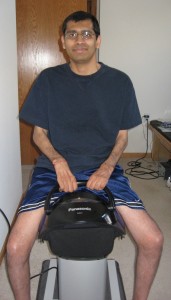
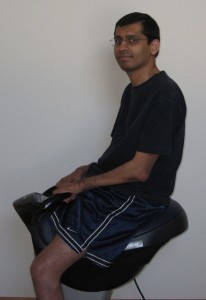
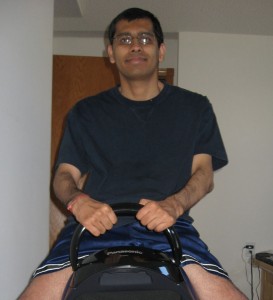
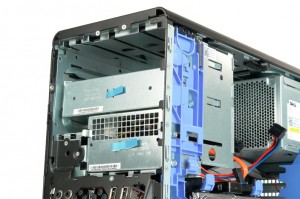
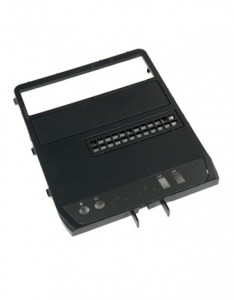
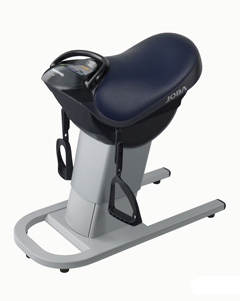
 Facebook
Facebook LinkedIn
LinkedIn